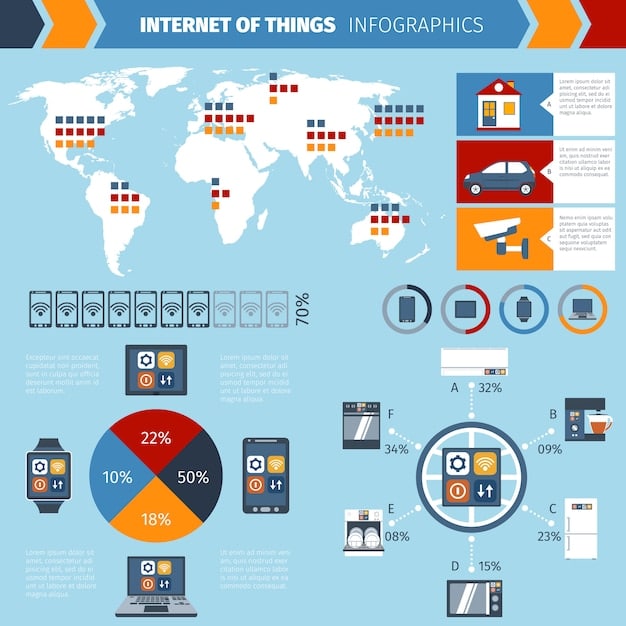Data Privacy for Streaming: New Regulations & Your Rights in the US

New regulations on data privacy for streaming subscribers are emerging in the US, granting consumers enhanced rights regarding how their personal data is collected, used, and shared by streaming services, ensuring greater control and transparency.
Are you concerned about how streaming services use your data? New regulations are changing the landscape of data privacy for streaming subscribers in the US. It’s crucial to understand what rights you now have to protect your personal information.
Understanding the New Landscape of Streaming Data Privacy
The digital entertainment industry is booming, but so is the amount of data collected by streaming services. Recent regulations aim to address the growing concerns about how this data is used, providing consumers with more control over their personal information. This section will delve into the key changes and what they mean for you.
The Rise of Data Collection in Streaming
Streaming services collect vast amounts of data, from viewing habits to device information. This data is used for various purposes, including personalized recommendations and targeted advertising. However, the lack of transparency and control over this data has raised significant privacy concerns.
Key Changes in Data Privacy Regulations
New regulations are introducing several key changes to data privacy for streaming subscribers. These include the right to access your data, the right to correct inaccuracies, and the right to opt out of certain data collection practices. These changes are designed to empower consumers and ensure greater transparency.
- Right to access your data collected by streaming services.
- Right to correct inaccurate personal information.
- Right to opt-out of data collection for targeted ads.
- Increased transparency regarding data usage policies.
In summary, the new regulations mark a significant step forward in protecting the data privacy of streaming subscribers. By understanding your rights and taking proactive steps, you can safeguard your personal information and enjoy a more secure streaming experience.
What Data Do Streaming Services Collect?
Before diving into your rights, it’s important to understand the types of data streaming services collect. This information can range from basic demographics to detailed viewing habits. Knowing what data is being collected is the first step in protecting your privacy.

Types of Data Collected
Streaming services collect a wide range of data, including:
- Viewing History: What shows and movies you watch, when you watch them, and how long you watch them for.
- Device Information: The type of device you use to stream, your operating system, and your IP address.
- Location Data: Your general location, which can be inferred from your IP address.
- Payment Details: Your credit card information or other payment methods used to subscribe to the service.
- Demographic Information: Your age, gender, and other demographic details you provide when signing up.
How is This Data Used?
The data collected by streaming services is used for various purposes, including:
- Personalized Recommendations: To suggest shows and movies that you might like based on your viewing history.
- Targeted Advertising: To show you ads that are relevant to your interests and demographics.
- Service Improvement: To analyze viewing patterns and improve the quality of the streaming service.
- Content Development: To determine what types of shows and movies to produce or acquire.
Understanding the types of data collected and how it’s used is essential for making informed decisions about your privacy. By being aware of what information is being gathered, you can take steps to protect your personal data and control how it’s used.
Your Enhanced Rights as a Streaming Subscriber
The new regulations provide you with several key rights regarding your data. These rights empower you to take control of your personal information and ensure that streaming services are transparent about their data practices. This section will explore these rights in detail.
The Right to Access Your Data
You have the right to request access to the personal data that streaming services have collected about you. This includes your viewing history, device information, and demographic details. Streaming services are required to provide this information to you in a timely and accessible manner.
The Right to Correct Inaccuracies
If you believe that any of the personal data that streaming services have collected about you is inaccurate or incomplete, you have the right to request that it be corrected. Streaming services are required to investigate your request and make any necessary corrections.

The Right to Opt-Out of Data Collection
In many cases, you have the right to opt-out of certain data collection practices, such as the use of your data for targeted advertising. Streaming services are required to provide you with clear and easy-to-use opt-out mechanisms.
Exercising Your Rights
To exercise your rights, you’ll typically need to contact the streaming service directly. Most services have a privacy policy on their website that explains how to make such requests. Be prepared to provide proof of your identity to ensure that your request is properly processed.
The new regulations empower you to take control of your data privacy. By understanding and exercising your rights, you can ensure that streaming services are transparent and accountable for their data practices.
How to Implement Privacy Settings on Popular Streaming Platforms
Many streaming services offer built-in privacy settings that allow you to control how your data is collected and used. Learning how to navigate these settings can significantly enhance your privacy. This section will provide a guide to implementing privacy settings on some popular streaming platforms.
Netflix
Netflix offers several privacy settings that allow you to control your viewing history and personalized recommendations. You can access these settings by:
- Logging into your Netflix account on a web browser.
- Navigating to “Account” and then “Privacy Settings.”
- Adjusting settings related to viewing activity and ad personalization.
Amazon Prime Video
Amazon Prime Video has privacy settings that control how your viewing data is used for personalized recommendations. You can manage these settings by:
- Going to “Your Account” on the Amazon website.
- Selecting “Video Settings” and then “Privacy.”
- Adjusting preferences for personalized recommendations.
Hulu
Hulu allows you to control the use of your data for targeted advertising. You can access these settings by:
- Logging into your Hulu account on a web browser.
- Going to “Account” and then “Privacy and Settings.”
- Adjusting preferences for advertising and data collection.
Disney+
Disney+ offers privacy settings that allow you to manage your data preferences. You can find these settings by:
- Accessing your profile settings within the Disney+ app.
- Looking for options related to data collection and personalization.
- Adjusting settings to suit your privacy preferences.
Implementing privacy settings on these platforms can help you take greater control of your data. Regularly reviewing and adjusting these settings is a good practice to ensure your privacy preferences are maintained.
Potential Challenges and Limitations
While the new regulations represent a significant step forward, there may be challenges and limitations in their implementation and enforcement. Understanding these potential issues can help you navigate the streaming landscape effectively. This section will discuss some of these challenges.
Enforcement Difficulties
Enforcing data privacy regulations across various streaming services can be complex. Streaming services may operate in multiple jurisdictions, making it difficult for regulatory bodies to oversee their data practices effectively. In addition, some streaming services may not be fully transparent about their data practices, making it challenging to detect violations.
Technological Limitations
Technological limitations can also pose challenges to data privacy. For example, it may be difficult to completely prevent streaming services from collecting certain types of data, such as your IP address. In addition, some data collection practices may be deeply embedded in the technology used by streaming services, making it difficult to opt-out entirely.
Despite these challenges, the new regulations provide a framework for protecting your data privacy. By staying informed and advocating for stronger enforcement, you can help ensure that streaming services are held accountable for their data practices.
Future Trends in Streaming Data Privacy
The landscape of streaming data privacy is constantly evolving. As technology advances and consumer awareness grows, we can expect to see further developments in this area. This section will explore some potential future trends in streaming data privacy.
Increased Transparency and Control
One potential trend is increased transparency and control over your data. Streaming services may be required to provide you with more detailed information about how your data is collected, used, and shared. You may also have more granular control over your data, allowing you to opt-out of specific data collection practices.
Enhanced Security Measures
Another trend is enhanced security measures to protect your data from breaches and unauthorized access. Streaming services may invest in stronger encryption technologies and implement more robust data security protocols to safeguard your personal information.
Stricter Regulations
In the future, we may see stricter regulations on streaming data privacy. These regulations could include more stringent enforcement mechanisms and greater penalties for violations. Governments and regulatory bodies may also work together to create a more harmonized approach to data privacy across different jurisdictions.
In conclusion, the future of streaming data privacy is likely to be shaped by increased transparency, enhanced security, and stricter regulations. By staying informed and engaging in advocacy efforts, you can help ensure that your data is protected in the evolving streaming landscape.
| Key Point | Brief Description |
|---|---|
| 🔑 Accessing Your Data | Learn how to request your data from streaming platforms. |
| 🛡️ Correcting Information | Steps to correct inaccurate personal data on streaming services. |
| ⚙️ Privacy Settings | How to adjust privacy settings on popular platforms like Netflix. |
| 🚫 Opting Out | Understand your right to opt-out of data collection. |
Frequently Asked Questions
▼
You have the right to access your data, correct inaccuracies, and opt-out of certain data collection practices. These regulations aim to provide you with greater control over your personal information.
▼
Contact the streaming service directly through their privacy policy page. Most services have a dedicated section explaining how to submit a data access request. You may need to provide proof of identity.
▼
Streaming services collect data like viewing history, device information, location data, payment details, and demographic information. This data is used to personalize recommendations and improve the service.
▼
Contact the streaming service through their privacy policy page and submit a correction request. You will usually need to provide details about the inaccuracy and supporting documentation.
▼
Document the violation and file a complaint with the appropriate regulatory body, such as the Federal Trade Commission (FTC). You may also consider seeking legal advice to explore your options.
Conclusion
The new regulations on data privacy for streaming subscribers mark a pivotal moment in protecting consumer rights in the digital age. By understanding and exercising these rights, you can take control of your personal information and ensure greater transparency from streaming services.





